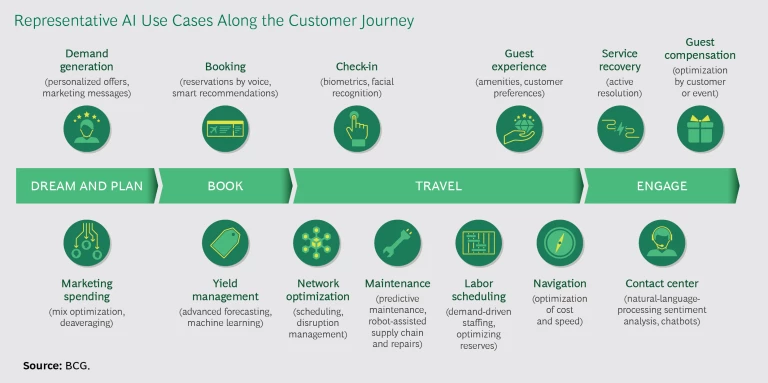Artificial intelligence (AI) has not yet taken off in the travel industry, but it hasn’t been for lack of trying. Most large travel companies have run pilots, tested proofs of concept, and experimented with various AI tools, but few have realized the benefits of AI that leaders in other industries have experienced.
This is a missed opportunity. Travel companies are rich in data. They confront both internal complexity of operations, scheduling, and pricing as well as external complexity influenced by GDP, fuel prices, weather, and terrorism. These characteristics play to AI’s strengths.
Travel companies are rich in data, and the industry’s characteristics play to AI’s strengths.
AI can help travel companies boost operational efficiency, route optimization, and yield management; improve loyalty programs and broader customer journeys; and speed back-office processes in accounting and finance. But to ensure tangible and sustainable value, companies need to do more than experiment. They need to align their leadership, capabilities, behavior, and operating model with a technology different from any other they have ever encountered.
AI’s Potential in Travel
In simple terms, AI is a machine-based system that absorbs data, adapts to change, and takes action or provides information that helps businesses make better and faster decisions. Machine learning is a subset of AI that involves actually learning from, rather than simply processing, data. (Executives who want a more thorough understanding of AI can review Putting Artificial Intelligence to Work, BCG Focus, September 2017; and “Ten Things Every Manager Should Know About Artificial Intelligence,” BCG article, September 2017.)
For travel companies, AI offers great potential in at least four largely untapped areas.
Tapping into a Data-Rich Environment. Travel companies have large amounts of information that they are not fully exploiting—everything from macroeconomic data, geopolitical developments, and weather trends to indicators of customer behavior collected through loyalty programs and operational data gathered from sensors onboard planes and ships. And their work with third parties gives them access to even richer data sets.
Recently, BCG worked with a global airline to optimize the personalization of customer emails with destination offers, loyalty messages, and other tactics. We worked with the carrier to build and test several machine-learning predictive models that took into account more than 3,000 variables including customer, booking, and external data. The subsequent emails had a hit, or open, rate two times higher than a control group and generated a 10% boost in revenue.
Managing Complex Operations. Many travel companies oversee vast operational footprints that could use help. First, many of the underlying systems—which were once state of the art—would benefit from the insights into efficiency and scheduling that machine learning can offer. Second, the operations that move people from place to place play an outsize role in pleasing or disappointing customers, smoothing journeys, and improving the overall experience. AI can help reduce friction at certain key moments, especially during complex activities that involve the largest number of people, processes, and systems.
For example, Dutch airline KLM and BCG are jointly developing AI-enabled decision-support tools that help predict delays, optimize aircraft and crew scheduling, and improve the passenger experience. These tools quickly analyze many scenarios, taking into account crew positions and availability, aircraft positions, and maintenance programs. Armed with this analysis, frontline staff can focus on making integrated decisions that boost operational performance.
At a major rail operator, executives wanted to use AI to reduce maintenance costs. BCG helped the operator consolidate years of scanning data in order to identify risk patterns that would suggest a need to repair a section of track. This predictive-maintenance engine helped reduce maintenance costs by 10%, improved network utilization, and created an opportunity to sell the tool to other rail companies.
Removing Friction in High-Stakes Customer Touch Points. Customers often interact with several travel companies at different stages of their journey. (See the exhibit.) Many of these interactions, such as delays related to weather or unforeseen mechanical breakdowns, are emotionally charged and beyond the companies’ control. Nonetheless, customers frequently hold the companies responsible. After all, the travel was sold as an experience or even a dream, not a nightmare.
AI can help anticipate and respond to such lapses even if the company was not at fault. In his book Setting the Table, famous New York restaurateur Danny Meyer talks about “writing a great last chapter” when dealing with a dissatisfied customer. He encourages employees to turn a mistake into a positive experience that the customer will remember. Machine learning can help travel companies write the last chapter by, for example, suggesting complementary services that the customer has accessed in prior trips or anticipating their unstated needs and wishes as inferred from past interactions.
Managing Demand with Greater Sophistication. In other industries, AI has been a boon to channel and yield management as companies have begun to rely on machine learning to forecast demand and optimize production across channels and markets.
Travel companies have been making similar decisions for decades but generally without the assistance of machine learning. They decide how many rooms to allocate to online travel agencies or seats to low-cost fares on the basis of traditional analysis and good, old-fashioned intuition. With commissions of 15% to 20% for agencies, rising direct-marketing costs, and significant investments in loyalty programs, these forecasting decisions are critical to the bottom line. And, as in the KLM-BCG airline operations solution, machines can remove the drudgery of the exercise and free marketing and pricing executives to think more strategically.
Marriott has jumped at this opportunity to improve profitability. In mid-2018, the hotelier announced the rollout of a new, AI-based system that relies on machine learning to understand demand and willingness to pay on the basis of room type, cyclicality, seasonality, and nearby special events. CEO Arne Sorenson has said publicly that the new system has already helped to lower reliance on high-cost channels at times of peak demand.
AI can take the drudgery out of forecasting decisions and free marketing and pricing executives to think more strategically.
Practical Steps to Generating Value with AI
The opportunities for AI in travel are real but difficult to achieve. All companies confront what we call the 10-20-70 problem of machine learning. About 10% of the challenge of implementation involves data science and the algorithms themselves, while 20% relates to the need for enabling technology infrastructure and data engineering. The final 70% covers embedding AI into business processes and adjusting ways of working so that people will use these new tools and create business value. The 10% is not trivial, requiring a deep understanding of both data science and the underlying business problem. But too often, companies spin their wheels on that 10% without ever making substantive business progress. (See The Big Leap Toward AI at Scale, BCG Focus, June 2018.)
In helping travel companies introduce AI pilots and bring the successful ones to scale, we have crafted several recommendations that address the context of the industry and the 20% and 70% challenges that companies often overlook.
Understanding the Value Potential and Landscape. Travel companies should analyze AI’s potential in internal operations and along customer journeys and focus on those sweet spots that will create the most value with available or accessible data. As part of this analysis, they should understand where competitors, partners, or digital upstarts may be trying to use AI and how these developments will affect their strategic advantage. This analysis should expose opportunities that can serve as the basis for pilot projects. In some cases, a business case may be so clear that it makes sense to accelerate or narrow the piloting phase.
Gathering and Coordinating the Data and Managing the Algorithms—the 20%. Travel companies are awash in data, but many of them have not fully collected, organized, and evaluated it. For example, cruise operators have an enormous amount of data onboard but must decide what gets replicated onshore. At the same time, travel companies need to bring together data from many touch points and silos, often outside their organization. For example, to deliver targeted offers for an ancillary product or benefit, companies need an end-to-end understanding of customer journeys, including interactions with other companies.
Travel companies are awash in data, but many have not fully collected, organized, and evaluated it.
Once they have corralled their data, companies have a related challenge: orchestrating the data as it moves through the algorithms. A typical IT system consists of data input, a tool, and data output. They are relatively easy to scale because the tool is static. But AI algorithms learn by ingesting data—the training data is an integral part of the AI tool. This “entanglement” of data and tool is manageable during pilots but becomes exponentially more difficult to address as AI systems interact and build upon one another. Travel companies need to buy or build a solution to monitor workflow from data input to final action.
Finally, companies need to ensure that they have the storage, computing, and bandwidth to handle multiple AI engines. The flexibility of the cloud makes it a preferred option to address these needs. But in certain contexts, such as cruise lines and operational control centers, latency and bandwidth constraints may prevent the cloud from serving as a complete solution. These settings require novel structures, such as edge computing, in which part of the processing power is kept closer to the periphery.
Most companies will ultimately need a relatively small number of data scientists and AI experts. But to integrate AI decision making into ongoing processes, they need a large number of data engineers to ensure the performance and resilience of the pipeline and peripheral systems.
Moving Beyond Pilots on an Organizational and People Level—the 70%. The second- and third-order consequences of introducing AI are exacerbated at travel companies because their processes are complex (an airline operations control center or revenue management department) and often frenetic (the back of the house of a cruise ship or hotel).
Successful operational AI projects need to bring key stakeholders together, manage change, and coordinate all the moving parts. At a high level, executives must address a delicate three-dimensional organizational balancing act:
- Centralized Activities. Data is the raw material of AI and contains some of the company’s most sensitive intellectual property. As such, data management, expertise, and governance should be centralized so that the company can take advantage of scale, consistency, and security.
- Embedded Activities. Business units or function s should oversee the development of pilots and use cases. The idea is to integrate AI into the fabric of the organization. The teams overseeing AI projects need to be flexible and iterative to accommodate the self-learning nature of AI machines. Many companies rely on variations of agile to ensure that the team’s way of working reflects AI’s way of working. Given the decentralized structure of so many travel companies, creating these agile teams can be especially challenging but is nonetheless critical. Left to their own, data scientists can come up with exquisite but impractical solutions.
- Decentralized Action. Finally, AI action should remain decentralized. In the travel industry, this often means putting AI-enabled decision-making authority in the hands of frontline staff in the operaions center, at the front desk of a hotel, or in the kitchen. A travel company that wanted to reduce food waste in its kitchens, for example, created an AI tool to achieve economies in food preparation. The chefs were then given mobile apps that suggested how much they should be cooking by the hour. Food waste has since dropped by roughly 40%. Because the chefs had a hand in the design of the app, they were more likely to trust its recommendations.
In addition to this balancing act, executives need to prepare their teams to work with AI and create thoughtful change management programs. The technology often unnerves employees, even though it generally improves their work life. Similar to the chefs in the example above, employees are happy to have better information at their disposal.
As AI plays a larger role, however, the machines that initially helped improve performance and reduce drudgery can cause job security concerns. Companies should start addressing these anxieties through change management and reskilling programs. One approach, adopted by leaders in AI such as Renault, is to create a digital hub, a large center dedicated to digital training.
The travel industry is at a critical inflection point that will determine whether individual companies stay stuck in the world of experimentation or achieve scale and meaningful results through AI. The industry’s next wave of competitive advantage will benefit companies that can make that transition across several areas of their business.
A senior leader at a travel client recently told us, “Much of our organization is stuck in the buzzwords and can’t yet even imagine what AI could do for us.” It’s time for all travel companies to fire up their imaginative powers and get to work putting their ideas into practice. If they don’t, the proverbial kids in the garage almost certainly will.







